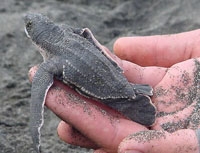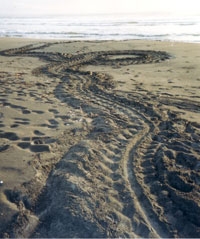The Leatherback Turtle (Dermochelys coriacea) is the critically endangered giant of the turtle world and it is this species which is the main object of all our three projects. It can have an overall length of over two metres and an adult may weigh from 350 to 700 kilos. The heaviest recorded was one which was drowned in a fishing net off the coast of Wales in 1988. It weighed over 900 kilos.
The Leatherback differs from other turtles in two important aspects. It does not have a carapace of shell. Instead, it is of thick black leather with seven longitudinal ridges, or keels. Also, unlike other turtles, it is able to raise its body temperature well above that of the surrounding water. This factor, combined with the Leatherback's thick and oily covering, enables it to inhabit waters far too cold for other turtles.
Leatherbacks nest on tropical beaches but can cross the Arctic Circle in search of food. They are the world's champion divers. The deepest recorded depth is 1.2 kilometers (3,900 ft), slightly more than the deepest known dive of a sperm whale.
When you see a Leatherback out of the water it is a very slow and clumsy creature, hardly able to heave itself over the sand, but in the water it is a fast and agile swimmer pushed along by its powerful front flippers. It has poor hearing and eyesight but a keen sense of smell.
Every Leatherback has a pink mark on the top of its head and each one's mark is different. Like the fingerprints of a human, it is useful for identification.
The principal food of the Leatherback is jellyfish. In fact, some marine biologists say that it only eats jellyfish.
The number of Leatherback nests on the beaches at Pacuare has varied greatly year on year.
Pacuare over the last ten years has varied from 1400 nests in a season down to 500 and now slightly higher at 600. Soropta beach in Panama has counted up to 400 in a season but its importance is far greater than just the number of nests, for it was on Soropta that the worst of the Leatherback slaughter in Panama used to take place. Whereas in Costa Rica the poachers take only the eggs, in Panama the Leatherback was killed for its meat and Soropta beach suffered most. Up to 35 Leatherbacks were being killed each year which would have led to the extinction of the colony but since 2002, when we started patrolling a vital 6 kms of Soropta, we have lost only one turtle to the poachers. Constant patrolling by our biologist, volunteers and guards have kept the poachers away.
The Leatherbacks we protect are part of the family that nest on the tropical beaches of the western Atlantic from the Caribbean northwards. After nesting, they swim to the North and North-East, moving up the US east coast and then across the Atlantic, well able to withstand the cold sea temperatures. Turtles tagged at Pacuare have been seen later off the coast of Spain and the UK. After two or three years wandering in this fashion, the females return to the tropics and to the same area of beaches - but not necessarily the same beach - from which they set off. Then comes another laying season during which they will lay 7-9 clutches of eggs at intervals of about 10 days.
The family of Leatherbacks that nest on the south side of the Caribbean, in Surinam and Trinidad, turn eastwards after nesting and head towards West Africa.
Thanks to the development of satellite transmitters, the migration routes are becoming better known. For instance, it has recently been shown that Leatherbacks that lay on the beaches of New Guinea swim all the way across the Pacific to feed on jellyfish in the cold waters off the US West Coast, before returning again to the same tropical beaches.
Almost nothing is known about the first years of a Leatherback's life. The hatchlings make for the sea after emerging from the nest and they are not seen again until many years later when the adult females, which have survived the countless predators, find a beach on which to lay their first clutch of eggs. The 'lost years' in between are a mystery. Nobody ever sees a half-grown leatherback and no reports come from sailors or fishermen of young Leatherbacks being seen at sea.
As Leatherbacks do not survive in captivity it is impossible to know for certain at what age they reach maturity. The experts' estimate has come down from 30 years to 8-12 years but opinions still differ.
As with all reptiles, it is the temperature of the eggs during incubation which decides whether the hatchling will be male or female. In the case of Leatherbacks, the critical temperature seems to be just below 29 Centigrade. Above that temperature there will be more females and vice versa. For this reason, the hatchlings from the top of the nest are more likely to be female as it is hotter nearer the surface. The sex of the turtle is decided between days 20 and 40 of the incubation period. Incubation can take from 60 to 75 days, depending upon the temperature in the nest.
Leatherback turtle hatchlings can be distinguished by the distinctive longitudinal markings on their backs.
The hatchlings do not leave the nest as soon as they have struggled out of the egg. Some of them are a long way down in the sand and it can take three days for the baby turtles to work their way up through the sand to just below the surface. There they wait until a drop in temperature gives them the signal to leave the nest and flap their way down towards the sea. This is always during the cool of the night when darkness gives them protection against many of the predators which hunt by day. However, night-feeding birds and ghost crabs are always on the prowl. Though no bigger than a baby turtle, a ghost crab can drag a hatchling down its hole in the sand.
A hatchling's problems are only just starting when it reaches the sea. A baby turtle is a tasty morsel for any number of fish. Frigate-birds and gulls will pick them off the surface with ease. The survivors swim on out to sea and nobody will see them again until years later when the adult females come back to lay. The males never come ashore again. Their scamper from the nest to the water's edge is the only time they touch dry land. Nobody knows the survival rate of hatchlings. It may be as low as one in a thousand.
The Leatherback's nesting takes place at night under cover of darkness and only very rarely does a turtle appear in daylight. The whole nesting process, from climbing the beach to the final return to the sea, can take up to an hour and a half.
After heaving itself over the sand, the turtle will look for a suitable nesting site, moving and turning within a small area. When it has found the right place, it will start to excavate a body-pit, using all four flippers to throw out the sand. In this way it makes a shallow depression for itself. It is then ready to excavate the egg chamber and this is done by the hind flippers only, which take out alternate scoops of sand until the depth of the chamber is exactly the length of the flipper. The last scoops may take out only a few grains of sand.
Once the egg chamber is completed, laying will start, with eggs dropping into the chamber three or four at a time, their soft shells ensuring that they never break. During the actual egg-laying the turtle goes into a semi-trance and so it is then that we can measure it for length and breadth, and, if it is not already tagged, place tags on each of its hind flippers. It will lay 80-90 full-sized eggs. These are the fertile eggs and they are followed by about 20 small eggs, which are infertile but fill the gaps between the larger ones on top, thus ensuring that there is air between the eggs in the nest.
As soon as it has dropped the last egg, the turtle starts to cover the eggs and fill the chamber with sand, using its hind flippers to pack the sand down very firmly. Once the chamber is filled, it begins to disguise the position of the nest by scattering sand with all four flippers, the front ones throwing sand far behind it. As it moves and turns, scattering sand as it goes, the immediate area is ploughed up by the turtle's massive front flippers. Soon it is impossible to tell where the nest is concealed, though a professional poacher will nearly always find it.
Eventually, the turtle will move towards the sea, often making a tight circle as it goes, finally heaving itself to the water's edge. It is a moving experience to see the exhausted turtle pause at the first breaking wave, then push off into deeper water and disappear into the darkness.
Information kindly provided by the Endangered Wildlife Trust
Conservation in Action holidays journeys and travel in Costa Rica - Volunteering with marine turtle conservation in Panama



